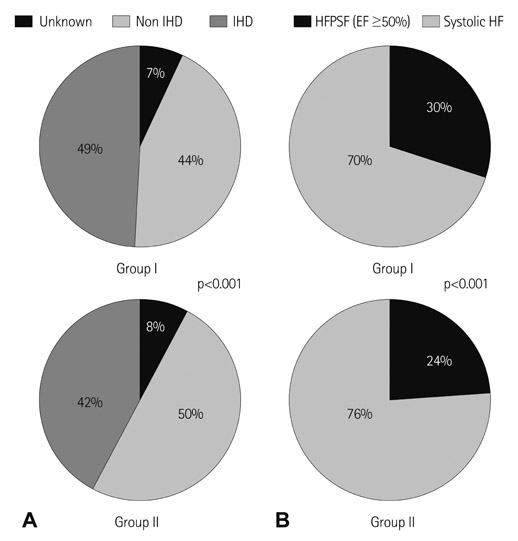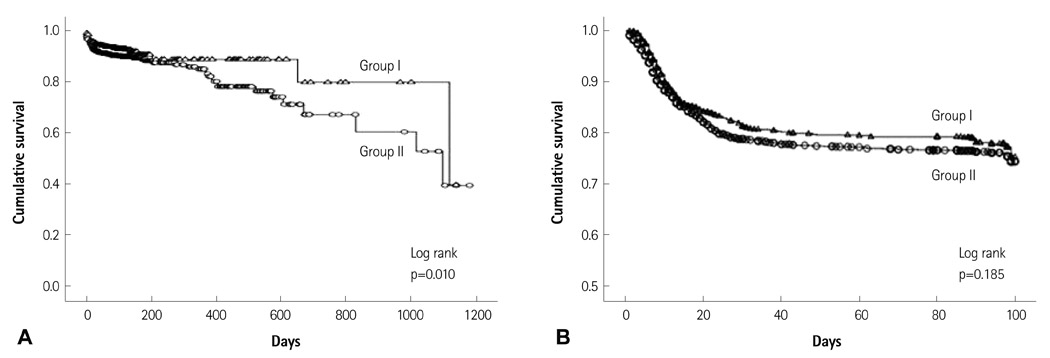Korean Circ J.
2013 Feb;43(2):87-92. 10.4070/kcj.2013.43.2.87.
The Prognostic Implication of Metabolic Syndrome in Patients with Heart Failure
- Affiliations
-
- 1Department of Cardiology, Chonnam National University Hospital, Gwangju, Korea. cecilyk@hanmail.net
- 2Department of Cardiology, Seoul National University College of Medicine, Bundang Hospital, Seongnam, Korea.
- 3Department of Cardiology, Hallym University College of Medicine, Kangnam Sacred Heart Hospital, Seoul, Korea.
- 4Department of Cardiology, Sungkyunkwan University College of Medicine, Samsung Medical Center, Seoul, Korea.
- 5Department of Cardiology, Chungbuk National University College of Medicine, Cheongju, Korea.
- 6Department of Cardiology, University of Ulsan College of Medicine, Asan Medical Center, Seoul, Korea.
- 7Department of Cardiology, Yonsei University Wonju Christian Hospital, Wonju, Korea.
- 8Department of Cardiology, Gachon University Gil Hospital, Incheon, Korea.
- 9Department of Cardiology, Chungnam National University Hospital, Daejeon, Korea.
- 10Department of Cardiology, Yonsei University Severance Hospital, Seoul, Korea.
- 11Department of Cardiology, Yeungnam University College of Medicine, Daegu, Korea.
- 12Department of Cardiology, Keimyung University College of Medicine, Daegu, Korea.
- 13Department of Cardiology, Kyungpook National University College of Medicine, Busan, Korea.
- 14Department of Cardiology, Seoul National University College of Medicine, Seoul, Korea.
- 15Department of Cardiology, Dongguk University College of Medicine, Ilsan Hospital, Goyang, Korea.
- 16Department of Cardiology, Hallym University College of Medicine, Dongtan Sacred Heart Hospital, Hwaseong, Korea.
- KMID: 1769643
- DOI: http://doi.org/10.4070/kcj.2013.43.2.87
Abstract
- BACKGROUND AND OBJECTIVES
Metabolic syndrome (MetS) increases the risk of heart failure (HF). The purpose of this study was to identify the prevalence of MetS in patients with HF and determine the syndrome's association with HF in clinical and laboratory parameters.
SUBJECTS AND METHODS
A total of 3200 HF patients (67.6+/-14.5 years) enrolled in a nationwide prospective Korea HF Registry between Jan. 2005 and Oct. 2009. Patients were divided into two groups according to the presence or absence of MetS at admission: group I (presence, n=1141) and group II (absence, n=2059).
RESULTS
The prevalence of MetS was 35.7% across all subjects and was higher in females (56.0%). The levels of white blood cells, platelets, creatinine, glucose, and cholesterol were significantly higher in group I than in group II. Left ventricular dimension and volume was smaller and ejection fraction was higher in group I than in group II. An ischemic cause of HF was more frequent in group I. The rates of valvular and idiopathic cause were lower in group I than in group II. The rate of mortality was lower in group I than in group II (4.9% vs. 8.3%, p<0.001).
CONCLUSION
Despite the increased cardiovascular risks in MetS, MetS was found to be associated with decreased mortality in HF.
Keyword
MeSH Terms
Figure
Reference
-
1. Levy D, Larson MG, Vasan RS, Kannel WB, Ho KK. The progression from hypertension to congestive heart failure. JAMA. 1996. 275:1557–1562.2. Qiao Q, Gao W, Zhang L, Nyamdorj R, Tuomilehto J. Metabolic syndrome and cardiovascular disease. Ann Clin Biochem. 2007. 44(Pt 3):232–263.3. Swedberg K, Cleland J, Dargie H, et al. Guidelines for the diagnosis and treatment of chronic heart failure: executive summary (update 2005): The Task Force for the Diagnosis and Treatment of Chronic Heart Failure of the European Society of Cardiology. Eur Heart J. 2005. 26:1115–1140.4. Eriksson H, Svärdsudd K, Larsson B, et al. Risk factors for heart failure in the general population: the study of men born in 1913. Eur Heart J. 1989. 10:647–656.5. Kenchaiah S, Evans JC, Levy D, et al. Obesity and the risk of heart failure. N Engl J Med. 2002. 347:305–313.6. Thethi T, Bratcher C, Fonseca V. Metabolic syndrome and heart failure. Heart Fail Clin. 2006. 2:1–11.7. Kahn R, Buse J, Ferrannini E, Stern M. American Diabetes Association. European Association for the Study of Diabetes. The metabolic syndrome: time for a critical appraisal: joint statement from the American Diabetes Association and the European Association for the Study of Diabetes. Diabetes Care. 2005. 28:2289–2304.8. Mechanick JI, Cobin RH, Einhorn D, et al. American College of Endocrinology/American Association of Clinical Endocrinologiest: Reaffirmation of 2003 ACE Insulin Resistance Syndrome (IRS) position statement. 2005. Available from: http://www.aace.com/pub/pdf/guidelines/IRSStatement.pdf.9. Soufer R, Wohlgelernter D, Vita NA, et al. Intact systolic left ventricular function in clinical congestive heart failure. Am J Cardiol. 1985. 55:1032–1036.10. Marantz PR, Tobin JN, Wassertheil-Smoller S, et al. The relationship between left ventricular systolic function and congestive heart failure diagnosed by clinical criteria. Circulation. 1988. 77:607–612.11. Hunt SA, Abraham WT, Chin MH, et al. ACC/AHA 2005 Guideline Update for the Diagnosis and Management of Chronic Heart Failure in the Adult: a report of the American College of Cardiology/American Heart Association Task Force on Practice Guidelines (Writing Committee to Update the 2001 Guidelines for the Evaluation and Management of Heart Failure): developed in collaboration with the American College of Chest Physicians and the International Society for Heart and Lung Transplantation: endorsed by the Heart Rhythm Society. Circulation. 2005. 112:e154–e235.12. Kannel WB, D'Agostino RB, Silbershatz H, Belanger AJ, Wilson PW, Levy D. Profile for estimating risk of heart failure. Arch Intern Med. 1999. 159:1197–1204.13. Chen YT, Vaccarino V, Williams CS, Butler J, Berkman LF, Krumholz HM. Risk factors for heart failure in the elderly: a prospective community-based study. Am J Med. 1999. 106:605–612.14. Ford ES, Giles WH, Mokdad AH. Increasing prevalence of the metabolic syndrome among u.s. Adults. Diabetes Care. 2004. 27:2444–2449.15. World Health Organization. Definition, diagnosis and classification of diabetes mellitus and its complications. Report of a WHO consultation. Part 1: diagnosis and classification of diabetes and mellitus. 1999. Geneva: World Health Organization.16. Expert Panel on Detection, Evaluation, and Treatment of High Blood Cholesterol in Adults. Executive Summary of The Third Report of The National Cholesterol Education Program (NCEP) Expert Panel on Detection, Evaluation, And Treatment of High Blood Cholesterol In Adults (Adult Treatment Panel III). JAMA. 2001. 285:2486–2497.17. Alberti KG, Zimmet P, Shaw J. IDF Epidemiology Task Force Consensus Group. The metabolic syndrome--a new worldwide definition. Lancet. 2005. 366:1059–1062.18. Huxley R, Mendis S, Zheleznyakov E, Reddy S, Chan J. Body mass index, waist circumference and waist: hip ratio as predictors of cardiovascular risk--a review of the literature. Eur J Clin Nutr. 2010. 64:16–22.19. Oh SW, Shin SA, Yun YH, Yoo T, Huh BY. Cut-off point of BMI and obesity-related comorbidities and mortality in middle-aged Koreans. Obes Res. 2004. 12:2031–2040.20. Park HS, Park CY, Oh SW, Yoo HJ. Prevalence of obesity and metabolic syndrome in Korean adults. Obes Rev. 2008. 9:104–107.21. Kalantar-Zadeh K, Block G, Horwich T, Fonarow GC. Reverse epidemiology of conventional cardiovascular risk factors in patients with chronic heart failure. J Am Coll Cardiol. 2004. 43:1439–1444.22. Horwich TB, Fonarow GC, Hamilton MA, MacLellan WR, Woo MA, Tillisch JH. The relationship between obesity and mortality in patients with heart failure. J Am Coll Cardiol. 2001. 38:789–795.23. McNeill AM, Katz R, Girman CJ, et al. Metabolic syndrome and cardiovascular disease in older people: the cardiovascular health study. J Am Geriatr Soc. 2006. 54:1317–1324.24. Denys K, Cankurtaran M, Janssens W, Petrovic M. Metabolic syndrome in the elderly: an overview of the evidence. Acta Clin Belg. 2009. 64:23–34.25. Ha JW, Oh JK. The pathophysiology and diagnostic approaches for diastolic left ventricular dysfunction: a clinical perspective. Korean Circ J. 2005. 35:865–876.26. Butler J, Rodondi N, Zhu Y, et al. Metabolic syndrome and the risk of cardiovascular disease in older adults. J Am Coll Cardiol. 2006. 47:1595–1602.27. Dinh W, Lankisch M, Nickl W, et al. Metabolic syndrome with or without diabetes contributes to left ventricular diastolic dysfunction. Acta Cardiol. 2011. 66:167–174.28. Wang J, Ruotsalainen S, Moilanen L, Lepistö P, Laakso M, Kuusisto J. The metabolic syndrome predicts cardiovascular mortality: a 13-year follow-up study in elderly non-diabetic Finns. Eur Heart J. 2007. 28:857–864.29. Wang J, Sarnola K, Ruotsalainen S, et al. The metabolic syndrome predicts incident congestive heart failure: a 20-year follow-up study of elderly Finns. Atherosclerosis. 2010. 210:237–242.
- Full Text Links
- Actions
-
Cited
- CITED
-
- Close
- Share
- Similar articles
-
- Clinical Implication of Mechanical Dyssynchrony in Heart Failure
- Renal Denervation for Chronic Heart Failure: Background and Pathophysiological Rationale
- Pharmacological Treatment of Heart Failure
- 2 Cases of Hypoplastic Left Heart Syndrome
- The Pathophysiology and Diagnostic Approaches for Diastolic Left Ventricular Dysfunction: A Clinical Perspective



